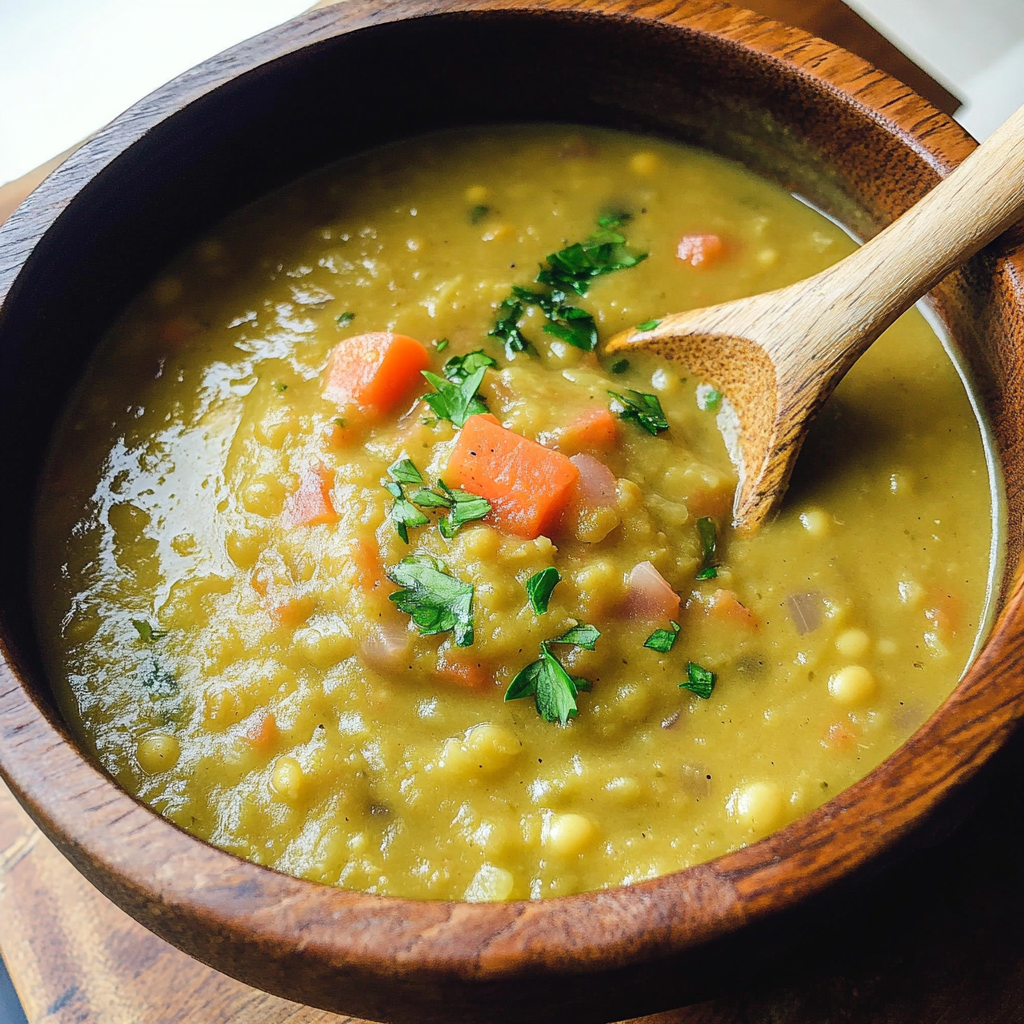Introduction: Why Split Pea Soup is a Classic Comfort Dish
Split pea soup is a timeless comfort food that has been cherished across generations. Known for its rich, hearty texture and savory flavor, this classic dish is perfect for cozy dinners, meal prepping, or even as a nutritious lunch. With its simple yet wholesome ingredients, split pea soup is easy to prepare and offers impressive health benefits.
One of the key reasons this soup remains so popular is its nutritional value. Packed with fiber, protein, and essential vitamins, split peas provide a filling meal that’s both satisfying and healthy. According to Healthline, split peas are an excellent source of plant-based protein and help promote digestive health.
Additionally, split pea soup is incredibly versatile. Whether you prefer a classic version with ham, a vegetarian twist, or something spiced with curry or chili flakes, this dish can be easily customized to suit your taste. Pair it with warm bread, a fresh salad, or roasted vegetables for a well-rounded meal.Try this Cookie and Kate Lentil Soup
With just a handful of ingredients and simple cooking methods like stovetop, slow cooker, or pressure cooker, you can create a comforting bowl of split pea soup that’s perfect for chilly evenings or satisfying weekday lunches.
The Origins of Split Pea Soup
The history of split pea soup dates back to ancient civilizations. Greek and Roman cultures often used peas in their diets, and by the Middle Ages, split pea soup had become a common meal in European households. In Scandinavian countries, it evolved into a Friday tradition.
For an interesting read on the evolution of this dish, check out the History of Split Pea Soup.
Key Ingredients for Split Pea Soup
To make the best split pea soup, you’ll need:
- Split peas (green or yellow)
- Ham bone, bacon, or vegetarian protein options
- Vegetables: onions, carrots, celery, and garlic
- Broth or stock (homemade or store-bought)
- Seasonings like bay leaf, thyme, and parsley
Step-by-Step Cooking Methods
1. Stovetop Method (Traditional)
- Soak split peas for 2-3 hours to speed up cooking.
- In a large pot, sauté onions, carrots, and celery in olive oil until tender.
- Add soaked peas, broth, and seasoning. Bring to a boil, then reduce heat and simmer for 60-90 minutes.
- Stir occasionally and add water if it thickens too much.
2. Instant Pot / Pressure Cooker Method
- Add all ingredients to the pressure cooker.
- Cook on high pressure for 15-20 minutes, then allow natural pressure release.
- Stir well to achieve desired texture.
3. Slow Cooker Method
- Add all ingredients to your slow cooker.
- Cook on low for 8 hours or high for 4-5 hours.
- Stir well before serving.
Best Variations of Split Pea Soup
Here are some creative ways to enhance your split pea soup:
- Classic Split Pea Soup with Ham — Perfect for leftover ham bones.
- Vegetarian Split Pea Soup — Replace meat with extra herbs and spices for added depth.
- Curried Split Pea Soup — Add curry powder and coconut milk for a rich, exotic twist.
- Spicy Split Pea Soup — Add chili flakes or jalapeños for a bold kick.
Pro Tips for the Perfect Split Pea Soup
- Rinse and sort your split peas to remove debris.
- For a thicker soup, simmer longer or use a blender for a creamy texture.
- To enhance flavor, cook with a ham bone, bacon, or smoked turkey.
- Don’t forget the seasoning — bay leaves, thyme, and garlic add rich depth.

Storage and Reheating Tips
Proper storage and reheating are key to preserving the rich flavor and ideal texture of your split pea soup. Follow these tips to keep your soup fresh and delicious.
Storing Split Pea Soup
To ensure your soup stays safe and tasty:
- Cool the Soup Properly: Allow the soup to cool to room temperature before transferring it to storage containers. Cooling too slowly can encourage bacterial growth, so aim to cool it within 2 hours.
- Use Airtight Containers: Store the soup in airtight glass or plastic containers to lock in freshness and prevent spills.
- Refrigerator Storage: Split pea soup will stay fresh in the fridge for up to 4 days.
- Freezing for Longer Storage: For best results, pour the soup into freezer-safe containers or resealable bags, leaving about 1 inch of space at the top to allow for expansion. Properly frozen, it can last for up to 3 months.
Pro Tip: For easy reheating, freeze your soup in individual portions — perfect for quick lunches or weeknight dinners.
Reheating Split Pea Soup
To restore your soup’s creamy texture and rich flavor:
- Stovetop Method: Transfer the soup to a pot and warm it over medium heat, stirring occasionally. Add a splash of water or broth if the soup has thickened too much.
- Microwave Method: Heat in a microwave-safe bowl, stirring every 30-60 seconds to ensure even warming.
- From Frozen: Thaw frozen soup overnight in the refrigerator for best results. Alternatively, you can reheat it directly from frozen by warming it gently on the stovetop with a splash of liquid to loosen the texture.
Serving Suggestions
- Top with fresh parsley, croutons, or grated cheese.
- Pair with warm sourdough bread or cornbread for a complete meal.
- For a balanced meal, serve with a fresh green salad or roasted vegetables.
Nutritional Benefits of Split Pea Soup
Split pea soup is not only delicious but also packed with impressive health benefits, making it a smart choice for a well-balanced meal.
Key Nutritional Benefits of Split Peas
- High in Fiber: Split peas are rich in soluble fiber, which aids digestion, stabilizes blood sugar levels, and helps lower cholesterol. A single cup of cooked split peas provides over 15 grams of fiber, supporting gut health and promoting a feeling of fullness.
- Excellent Source of Plant-Based Protein: With about 16 grams of protein per cup, split peas are ideal for vegetarians, vegans, and anyone looking to add more protein to their diet.
- Low in Fat and Calories: Despite being hearty and satisfying, split pea soup is naturally low in fat and calories, making it a great choice for those managing their weight.
- Rich in Vitamins and Minerals: Split peas are loaded with essential nutrients such as vitamin B1, folate, iron, potassium, and magnesium, which support energy levels, heart health, and immune function. Learn more about Health Benefits of Split Peas
Incorporating split pea soup into your diet can improve digestion, support heart health, and provide a nourishing, satisfying meal that’s perfect for both comfort and wellness.
Common Mistakes to Avoid
Even with its simple ingredients, split pea soup can sometimes go wrong. Here are some common mistakes to watch out for and how to avoid them:
1. Overcooking the Peas
While split peas should break down during cooking, simmering them too long can result in an overly mushy texture. To maintain the perfect consistency, cook the soup just until the peas are tender but still hold some shape.
2. Adding Too Much Liquid
Adding excessive broth or water can make your soup too thin. Start with a smaller amount of liquid and gradually add more if needed. If your soup becomes watery, simmer uncovered to reduce excess moisture.
3. Skipping the Soaking Step
Although split peas don’t always require soaking, soaking them for 2-3 hours can significantly reduce cooking time and improve texture.
4. Neglecting Seasoning
Split peas absorb flavor, so seasoning early and adjusting throughout cooking is crucial. Ingredients like bay leaves, thyme, and smoked paprika add depth.
5. Using Weak Broth
A bland broth can lead to a flat-tasting soup. For the richest flavor, use a robust homemade broth or a quality store-bought variety.
6. Forgetting to Stir
Split peas tend to sink and stick to the bottom of the pot. Stir occasionally to prevent burning and ensure even cooking.
FAQs About Split Pea Soup
Here are some commonly asked questions about split pea soup, offering practical solutions and tips to ensure success every time you make this classic dish.
Can I make split pea soup without ham?
Absolutely! While ham adds a rich, smoky flavor, you can easily create a delicious vegetarian split pea soup by incorporating ingredients like smoked paprika, miso paste, or liquid smoke for added depth. For a heartier texture, consider adding mushrooms or chickpeas.
How do I thicken split pea soup?
If your soup turns out too thin, try these methods to thicken it:
- Simmer the soup uncovered for an additional 15-20 minutes.
- Mash some of the peas directly in the pot to create a creamier consistency.
- Add a small amount of mashed potatoes or pureed vegetables for added body.
Why did my split pea soup turn out too thin?
This often occurs when too much liquid is added or if the peas are undercooked. To fix this:
- Continue simmering until the soup reaches your desired thickness.
- Stir frequently to ensure peas break down properly.
- Add cooked rice or barley for extra texture.
Can I make split pea soup in advance?
Yes! In fact, split pea soup often tastes even better the next day as the flavors have more time to meld. Store it in an airtight container in the fridge for up to 4 days or freeze for up to 3 months.
How long does split pea soup last in the fridge?
Properly stored in an airtight container, split pea soup will stay fresh for 3-4 days in the refrigerator.
What’s the best way to fix salty split pea soup?
If your soup turns out too salty:
- Add a peeled potato to the pot while simmering — it will absorb some of the excess salt.
- Alternatively, stir in a splash of unsalted broth, water, or a pinch of sugar to balance the flavor.
Can I use yellow split peas instead of green?
Yes! Both varieties cook similarly, but yellow split peas tend to have a slightly sweeter, milder flavor, while green split peas offer an earthier taste.
Is split pea soup gluten-free?
Yes, split peas themselves are naturally gluten-free. However, ensure your broth, seasonings, and any added meats are also free from gluten-based additives.
Conclusion
Whether you prefer the classic version with ham or a vibrant vegetarian twist, split pea soup is a satisfying, nutrient-packed meal perfect for any occasion. With its comforting taste, simple preparation, and rich history, this dish is sure to become a favorite in your kitchen.
Happy cooking! 😊



